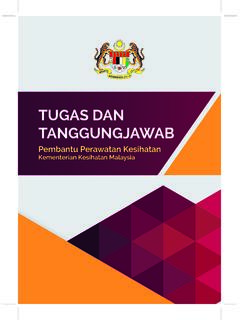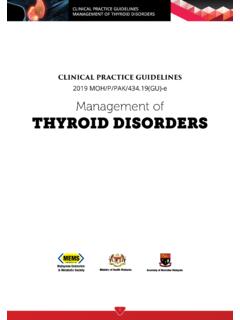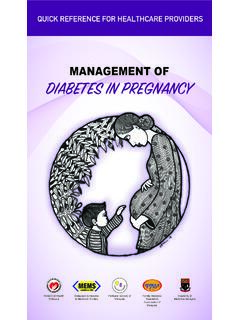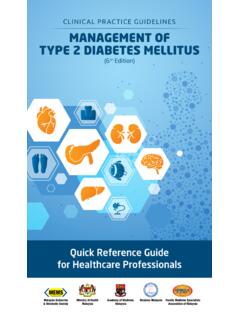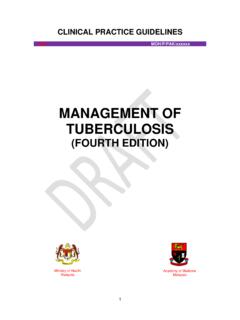Transcription of th Edition of Clinical Practice Guidelines Management of ...
1 July 2017 Management of Dyslipidaemia 2017 Edition of Clinical Practice GuidelinesthMOH/P/ (GU)20161 STATEMENT OF INTENTThis guideline was developed to be a guide for best Clinical Practice in the Management of dyslipidaemia, based on the best available evidence at the time of development. Specific attempts were made to use local data and publications to ensure local relevance. Adherence to this guideline does not necessarily lead to the best Clinical outcome in individual patient care. Every health care provider is responsible for the Management of his/her unique patient based on the Clinical presentation and Management options available locally. REVIEW OF THE GUIDELINEThis guideline is issued in 2017 and will be reviewed in about 5 years or earlier if important new evidence becomes SecretariatHealth Technology Assessment UnitMedical Development DivisionLevel 4, Block EI, Parcel EGovernment Offices Complex62590 Putrajaya, MalaysiaAvailable on the following websites: is an update to the Clinical Practice Guidelines on Management of Dyslipidaemia published in 2011.
2 This CPG supersedes the previous of Dyslipidaemia 20172 MESSAGE FROM THE DIRECTOR general OF HEALTHD yslipidaemia remains a significant problem in Malaysia, with the National Health and Morbidity survey in 2015 reporting an estimated 47% of the adult population having hypercholesterolaemia. In the main, dyslipidaemia is asymptomatic but its associations with serious vascular conditions such as acute myocardial infarction and stroke is well known. The previous Edition of the National Clinical Practice Guidelines (CPGs) were launched in 2011. Since then, the evidence base on this subject has grown and new treatments now available. In addition, more Clinical information on dyslipidaemia has emerged from Malaysia and the region. Therefore, this Edition , which is the 5th Edition of the CPG on the Management of Dyslipidaemia, is timely. Accessing this CPG, and others endorsed by the Ministry of Health, by healthcare providers is now easier, with the advent of modern telecommunications downloading a soft copy of this CPG should be a seamless affair.
3 I anticipate the readership of this and other such CPGs to grow and the information provided be useful for healthcare providers in their day to day Management of would like to congratulate the multidisciplinary team for working together for many months toproduce this CPG. Members of the this CPG Expert Panel consist of experts from both the private and public sectors, from primary to tertiary care centres, and from across the country. Under the capable and enthusiastic leadership of Dr Robaayah Zambahari, supported by Dr Jeyamalar Rajadurai, the Expert Panel regularly met to ensure the most recent and relevant information are incorporated into this CPG. I also thank members of the Panel of External Reviewers for their , I hope elements of this CPG will be put into Practice on a daily basis, to tackle the problem of dyslipidaemia in this country, and eventually result in a drop in mortality and morbidity associated with vascular disease.
4 I am sure this 5th Edition of the CPG on the Management of Dyslipidaemia (2017) will go a long way towards achieving Dr Noor Hisham AbdullahDirector general of Health MalaysiaEdition of Clinical Practice Guidelines5th3 MEMBERS OF THE EXPERT PANELDr Robaayah ZambahariChairperson:Dr Jeyamalar RajaduraiDr Abdul Rashid Abdul RahmanSecretary:Expert Panel Members (in alphabetical order):Consultant Cardiologist,National Heart InstituteConsultant Cardiologist,Subang Jaya Medical Centre, SelangorConsultant Physician, (Specialist in Cardiovascular Medicine), An-Nur Specialist HospitalDr Al Fazir Omar Consultant Cardiologist, National Heart Institute, Kuala LumpurDr Alan Fong Yean Yip Consultant Cardiologist, sarawak general hospital Dr Aris ChandranConsultant Physician,UniKL-RCMP, IpohDr Chan Siew PhengConsultant Endocrinologist, Subang Jaya Medical Centre, SelangorLecturer & Family Medicine Specialist,Department of Primary Care Medicine, Faculty of Medicine & Defence Health, National Defence University Dr Hasliza Abu HassanChief Dietitian, National Heart InstituteMs Mary EasawPhysician, hospital Sungai Buloh Dr Mohd Rahal Yusoff Clinical Pharmacist, hospital Kuala LumpurMs Nirmala JaganConsultant Cardiologist, Gleneagles PenangDr Ong Mei LinProfessor, Head of Cardiology Unit, University Malaya Medical CentreDr Wan Azman Wan AhmadConsultant Endocrinologist.
5 hospital PutrajayaDr Zanariah HusseinManagement of Dyslipidaemia 20174 EXTERNAL REVIEWERS(in alphabetical order)Dr Hashim Nor general Physician,Klinik Doctors Young, Newton & PartnersProf Dato Dr Ikram Shah IsmailSenior Consultant Endocrinologist,University Malaya Medical CentreDr Nazrila Hairizan Nasir National Head of Family Medicine Services,Consultant Family Medicine,Klinik Kesihatan, Precint 9 PutrajayaDr Sunita Bavanandan Senior Consultant Nephrologist, hospital Kuala LumpurDr Wan Abdul Rahim Wan Muhammad Public Health Physician,Non-Communicable Disease Section, Department of Health,PahangDr Hew Fern Lee Consultant Endocrinologist, Subang Jaya Medical Centre, SelangorDatuk Dr Kauthaman a/l A MahendranConsultant Physician,Department of MedicineHospital MelakaDato Dr Omar Ismail National Advisor for Cardiology Services, Consultant Cardiologist & Head, Department of Cardiology, hospital Pulau PinangProf Dr Tilakavati Karupaiah Professor & Head of Dietetics Program, Faculty of Health Sciences.
6 Universiti Kebangsaan MalaysiaDr Wardati Mazlan Kepli, PhdClinical PharmacistPharmacy DepartmentHospital SerdangEdition of Clinical Practice Guidelines5th5 RATIONALE AND PROCESS OF GUIDELINE DEVELOPMENTR ationale:In Malaysia, cardiovascular disease (CVD) is the leading cause of death in both men and women1. CVD includes coronary heart disease (CHD), cerebrovascular disease and peripheral arterial disease. CHD is a spectrum ranging from stable angina to acute coronary syndromes (ACS). The prevalence of the common cardiovascular (CV) risk factors dyslipidaemia, hypertension, diabetes, smoking and overweight/obesity have been on an increasing trend. Malaysians develop heart disease (ACS) at a younger age when compared to people in Thailand, mainland China and western countries. Our local NCVD-ACS Registry (2011-2013), showed that most patients ( ) had at least one established CV risk factor hypertension (65%), dyslipidaemia (37%) and/or diabetes (46%)2.
7 In preventing CVD, efforts should be aimed at reducing global risks. This Clinical Practice Guideline (CPG) is on Management of dyslipidaemia. The last CPG (4th Edition ) was published in 2011. Thus the need for an :The objective of this Clinical Practice guideline is to review: The Clinical evidence linking dyslipidaemia and atherosclerosis. Atherosclerosis affects the entire vascular tree. However, evidence for a causal link is strongest for CVD (heart disease and strokes). Strategies for assessing CV risk that is most applicable to our local population. Evidence based Management of dyslipidaemia, utilising existing healthcare resources wherever :This CPG has been drawn up by a committee appointed by the National Heart Association of Malaysia, Ministry of Health and the Academy of Medicine. It comprises cardiologists, endocrinologists, general physicians, pharmacists and dieticians from the government and private sectors as well as from the search was carried out using the following electronic databases PubMed and Cochrane Database of Systemic Reviews.
8 The following MeSH terms or free text terms were used either singly or in combination: Hyperlipidaemia ; Dyslipidaemia ; Hypercholesterolemia ; Cholesterol ; LDL-cholesterol HDL-cholesterol ; Triglycerides ; Diabetic dyslipidaemia 2017 Management of Dyslipidaemia 20176 The search was filtered to Clinical trials and reviews, involving humans and published in the English language. The relevant articles were carefully selected from this huge list. In addition, the reference lists of all relevant articles retrieved were searched to identify further studies. The search was conducted from August 2010 (date of last review for previous CPG) till 31st August Guidelines were also studied. Experts in the field were also contacted to obtain further information. International Guidelines mainly that from the American Heart Association/ American College of Cardiology (AHA/ACC) and the European Society of Cardiology were used as main references.
9 After much discussion, the draft was then drawn up by the members of the Expert Panel and submitted to the Technical Advisory Committee for Clinical Practice Guidelines , Ministry of Health Malaysia and key health personnel in the major hospitals of the Ministry of Health and the Private Sector for review and feedback. The Clinical questions were divided into major subgroups and members of the Expert Panel were assigned individual topics. The group members met several times throughout the development of the guideline. All retrieved literature was appraised by individual members and subsequently presented for discussion during group meetings. All statements and recommendations formulated were agreed collectively by members of the Expert Panel. Where the evidence was insufficient the recommendations were derived by consensus of the Panel. The draft was then sent to local external reviewers for comments.
10 It was also sent to the American College of Cardiology and the European Society of Cardiology for feedback. The level of recommendation and the grading of evidence used in this guideline was adapted from the American Heart Association and the European Society of Cardiology (ACC/ESC) and outlined on page 10. In the text, this is written in black on the left hand Questions Addressed:There were several topics and subtopics that were formulated using the PICO method, addressing diagnosis and therapy of diagnosis: Does measuring the lipid profile in the fasting as compared to the non-fasting state, result in a significant difference in the measured values? Does measuring the lipid profile in the fasting as compared to the non-fasting state, have an impact on cardiovascular risk estimation? Edition of Clinical Practice Guidelines5th2017 Management of Dyslipidaemia 2017 For therapy, the topics and subtopics were as follows:P.
